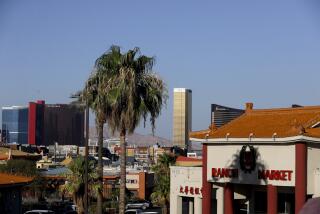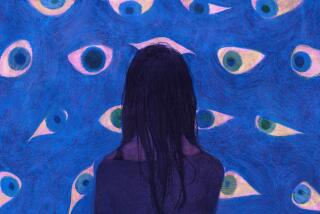Personal Health : For Asians in U.S., a New Focus on Eye Surgery
- Share via
The plastic surgeon bent over the operating table and held a small metal ruler up to the anesthetized patient’s face.
“Six millimeters,” he said, measuring the width of the eyelid. “We’ll bring it up to 12.” The doctor proceeded to draw green felt tip lines over her closed lids as his assistant sterilized the instruments.
The patient, Emogene Morita, had always thought her eyes made her look tired and unattractive. In high school, she had applied heavy makeup to create the illusion of a larger, more “Caucasian-looking” eyelid. Sometimes, she taped her lids up high to achieve the same effect.
But at 44, Morita, of Fountain Valley, decided she wanted a permanent change. She went to a plastic surgeon in Beverly Hills who lifted her eyelids by removing skin and fat, a procedure that took 1 1/2 hours and cost $4,500. Three of her Asian friends, she said, have undergone the same operation.
“I have a typical Asian-looking eye,” she said before surgery. “On my father’s side, we have the puffy eyes with a lot of fat and really straight, straight eyelids. But my mother’s eyes are Caucasian-looking. They’re very pretty.”
In the United States, plastic surgeons who once rarely saw Asian patients now are learning new techniques to satisfy a growing demand among Asian Americans for larger eyelids and taller noses. “Anglicizing” Asian eyes, and other ethnic features, is becoming a hot lecture topic at state-of-the-art cosmetic surgery seminars. UCLA’S Jules Stein Eye Institute, for example, recently began offering courses on the Asian eyelid surgery technique.
As in any surgery, results of the eyelid procedure--which is not new and has been practiced for years in East Asia--depend on the skill and sophistication of the surgeon and the facility. Some less advanced techniques can produce unsatisfactory results: sutures can pull out, causing eyes to revert to their original look; lifts can produce eyes that are asymmetrical.
There also are those who criticize the procedure, saying women who have it are trying to deny their heritage.
“Cutting eyes is like foot-binding,” said author Maxine Hong Kingston. “It’s a version of self-mutilation, worse than tattooing. It’s not creative. It’s a mutilation and a perversion.”
Judy Yung--a board member of Asian Women United, a San Francisco-based group that produces videotapes and books on Asian American women--said that opposition to plastic surgery to change Asian features is “definitely a minority opinion. Those who are repelled . . . are in the minority because the media are still dominating our sense of self and consciousness as Asian American women.”
But not every patient who has such surgery says they want it to look more Western or less Asian. Morita’s Beverly Hills plastic surgeon, Dr. Toby Mayer, says an Asian wanting wider eyelids is no different from a Caucasian woman having her lips injected with collagen to make them fuller: “Or say we had a woman from Italy who came to see me because she has a bump on her nose. She looks at a woman from Sweden and says she wants a nose like hers. Is the issue that she wants to look Swedish, or that she wants to look better? The issue is that she wants to look better.”
But, he added, “I realize my judgments (on beauty) are by Western standards.
The demand by Asian Americans for eye work has captured the attention of the American Academy of Cosmetic Surgery, which conducts annual surveys of its 2,000 or so members. For the first time last year, the survey asked plastic surgeons whether they have noticed an increase in ethnic minorities wanting more Westernized features.
“The answer was overwhelmingly yes,” said Kimberly Davey, an academy spokeswoman. Although statistics on each racial group were unavailable, Davey said Asians are the largest ethnic minority served by plastic surgeons; eyelid lifts are the most popular procedure. Surgeons in the San Gabriel Valley, with the largest concentration of Asians in Southern California, perform more eyelid lift surgery than in other parts of the country, but the higher numbers merely reflect the ethnic make-up of those communities.
Asian eyelid surgery originated in Japan after World War II, and quickly spread throughout East Asia, where it was commonly referred to as “westernizing the Oriental eye,” said Dr. Edward Falces, a San Francisco plastic surgeon and faculty member at Stanford University Medical Center.
In Asia, the technique--performed by beauticians more often than by medical doctors--is marketed as cheap, readily available and quick, taking as little as 20 minutes to do. Asian Americans have traveled to Hong Kong, Taiwan or the Philippines for the eye surgery, rather than paying up to three times as much to an American doctor.
But in American communities with large Asian populations, it’s easy to find doctors specializing in Asian blepharoplasty, the technical name for the operation in which part of the skin and fat on the eyelid is removed to produce a “double eyelid,” such as occurs naturally in Caucasians and other non-Asians.
Eyelid lifts, which cost from $900 in a county hospital to $4,000 with a private doctor, have been marketed aggressively on Chinese and Japanese television and in fashion magazines; advertisements for “Oriental Eyelid Surgery” have proliferated in two Asian American magazines, AsiaAm and the now-defunct Rice.
“Some are trying to make themselves more acceptable in a Western culture. That’s basically why they do it,” said Dr. Ronald Matsunaga, director of County-USC Medical Center’s facial plastic surgery deparment. “They get the magazines, the movies, they see all the models. They’re looking at the Western world.”
Matsunaga, who practices in Beverly Hills, performs about one Asian blepharoplasty daily. He also specializes in Asian nose surgery, or rhinoplasty, in which bones at the nose’s base are trimmed and cartilage is added to raise the bridge. Most of his patients are female, from their late teens to mid-40s, and come from across the country, as well as from East Asia.
But while some are drawn to the idea of Anglicizing ethnic features, others say it amounts to a kind of cultural suicide. Kingston said young Asian Americans have only white models and entertainers as role models for beauty because there’s a dearth of prominent Asian actresses and actors in the United States.
“Culture gives us many examples of Caucasian beauty or blond beauty but society does not teach us to look for our own beauty,” said Kingston, author of the best-sellers, “The Woman Warrior” and “China Men.”
“We do not even see our faces on television,” she said. “We have no starting point for our young people. They look at themselves in the mirror and all they have to compare themselves to is caricatures.”
The social implications of changing Asian features is an issue in “Tripmaster Monkey,” Kingston’s latest book, in which the protagonist delivers a speech describing the advantages of the Asian eye, only to be part of a group partygoers who are told by a young Japanese American woman that she despises her almond-shaped eyes and plans to fly to Hawaii to have them enlarged.
Elaine Kim, a professor of Asian American studies at the University of California at Berkeley, spent a year in South Korea teaching English at a women’s college. She said that when a Korean woman is eligible for marriage, her parents might send her to a doctor for a complete surgical make-over, including an eyelid lift and nose surgery. But, Kim added, trends are shifting among politically conscious Koreans who resent Western influences because “anti-American feelings are coming into vogue.
Dr. William Chen, assistant clinical professor at UCLA’s eye institute and medical director of the Eye Plastic Surgery Center of Southern California, warned that errors often occur when patients undergo surgery in less advanced Hong Kong and Taiwanese clinics. He recalled that one patient came to his office after going to Taiwan, where a surgeon had removed too much skin and fat from her left eye. The surgeon had tried to correct her sunken-in-look with skin grafts, which prevented the patient’s eye from closing completely, he said, adding that a fifth of his Asian blepharoplasty patients have had eyelid lifts done elsewhere and need corrective surgery.
In Korea, he noted, doctors commonly practice an outdated method of double eyelid surgery--turning part of the lid inside out and stitching it to create a “dimple” without removing tissue. This method is not permanent and the sutures loosen and eventually fall out.
Regardless of technique, plastic surgeons who alter ethnic characteristics often find themselves defending their practice against criticism that they perpetuate a Western ideal of beauty. “They’ve written articles about me in local Japanese papers taking me to task,” said USC’s Matsunaga.
It may seem ironic that plastic surgery among Asian Americans has grown so popular decades after ethnic pride movements have flourished in all segments of society. But the phenomenon does not surprise Yung, a doctoral candidate who is studying Asian American women.
In the 1980s, when Asian Americans have ascended the economic ladder and have been characterized as a “model minority,” they have become “highly Americanized and less and less aware or interested in their ethnic heritage and civil rights attitudes,” Yung said.
“They want to co-op into the system,” she said. “Despite the 1970s and alternative opinions about ethnic beauty, the majority are still desiring to look as American as they can. And because the ones who are successful are the most visible ones, they will set an example for others.”
A Korean American actor said he spent $10,000 to have his eyelids lifted, his nose done and his chin augmented. He expects it to pay professionally. Recalling he was teased as a boy in his all-white neighborhood about his “droopy eyes and flat nose,” the 18-year-old actor, who declined to identify himself, said he yearned for leading television roles but was stereotyped into “smart Oriental” parts.
“Now I’m noticing more smiles, more looks,” he said. “And I do think I’ll get more acting jobs.”
More to Read
Sign up for Essential California
The most important California stories and recommendations in your inbox every morning.
You may occasionally receive promotional content from the Los Angeles Times.










